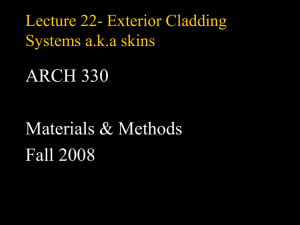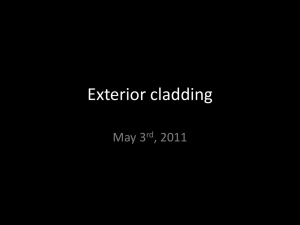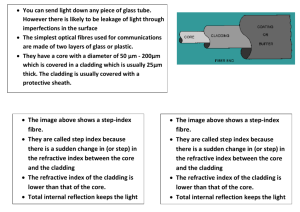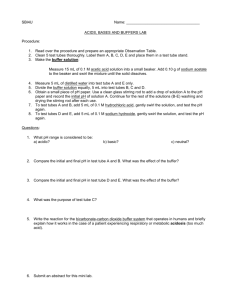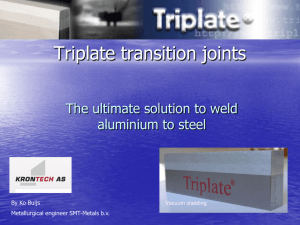Target Materials Development for SINQ and Out of Beam Testing 1
advertisement
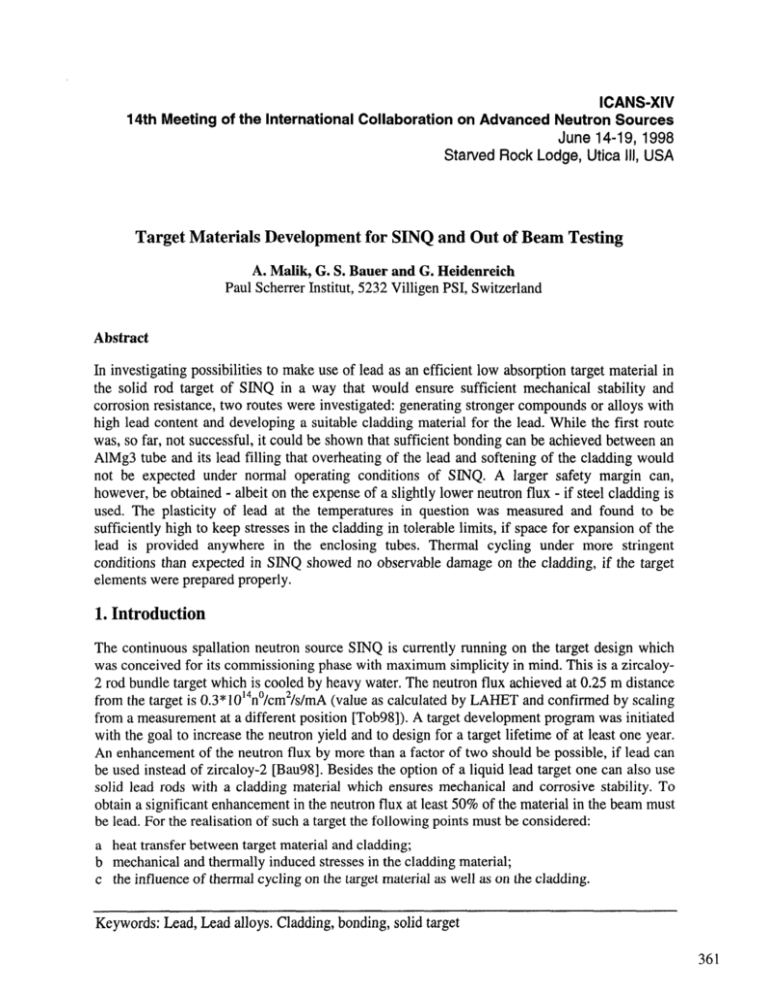
ICANS-XIV 14th Meeting of the International Collaboration on Advanced Neutron Sources June 14-19,1998 Starved Rock Lodge, Utica III, USA Target Materials Development for SINQ and Out of Beam Testing A. Malik, G. S. Bauer and G. Heidenreich Paul Scherrer Institut, 5232 Villigen PSI, Switzerland Abstract In investigating possibilities to make use of lead as an efficient low absorption target material in the solid rod target of SINQ in a way that would ensure sufficient mechanical stability and corrosion resistance, two routes were investigated: generating stronger compounds or alloys with high lead content and developing a suitable cladding material for the lead. While the first route was, so far, not successful, it could be shown that sufficient bonding can be achieved between an AlMg3 tube and its lead filling that overheating of the lead and softening of the cladding would not be expected under normal operating conditions of SINQ. A larger safety margin can, however, be obtained - albeit on the expense of a slightly lower neutron flux - if steel cladding is used. The plasticity of lead at the temperatures in question was measured and found to be sufficiently high to keep stresses in the cladding in tolerable limits, if space for expansion of the lead is provided anywhere in the enclosing tubes. Thermal cycling under more stringent conditions than expected in SINQ showed no observable damage on the cladding, if the target elements were prepared properly. 1. Introduction The continuous spallation neutron source SINQ is currently running on the target design which was conceived for its commissioning phase with maximum simplicity in mind. This is a zircaloy2 rod bundle target which is cooled by heavy water. The neutron flux achieved at 0.25 m distance from the target is 0.3” 10i4no/cm2/s/mA (value as calculated by LAHET and confirmed by scaling from a measurement at a different position [Tob98]). A target development program was initiated with the goal to increase the neutron yield and to design for a target lifetime of at least one year. An enhancement of the neutron flux by more than a factor of two should be possible, if lead can be used instead of zircaloy-2 [Bau98]. Besides the option of a liquid lead target one can also use solid lead rods with a cladding material which ensures mechanical and corrosive stability. To obtain a significant enhancement in the neutron flux at least 50% of the material in the beam must be lead. For the realisation of such a target the following points must be considered: a heat transfer between target material and cladding; b mechanical and thermally induced stresses in the cladding material; c the influence of thermal cycling on the target material as well as on the cladding. Keywords: Lead, Lead alloys. Cladding, bonding, solid target 361 A close look at target materials other than pure lead seemed to be useful, since the proton beam deposits up to 300 W/cm3 in the target. With lead having a comparatively low melting point of T,=600 K, the maximum temperature of approximately 423 K in the target is significantly higher than T,/2. A target material with a high melting point and good mechanical properties as well as a low neutron absorption cross section would be ideal. In parallel to searching for such a material also the heat transfer properties between lead and low absorption cladding materials, in particular aluminium and ways to improve it were examined. 2. Target material development 2.1. Lead alloys with a high melting point Lead zirconium alloys have been investigated as neutron multipliers for the fusion reactor technology. All of these investigations were done on the zirconium rich part of the phase diagram which, even there, is not well known. This means that there are no publications, which could be used as a basis. A fairly recent publication [Aria961 of thermodynamic data in the region of 50 at % Pb gave no reasonable values for extrapolations into the lead rich regions [Ha1196]. ZrsPb3 produced by hot isostatic pressing had a melting point of more than 1673 K but was very brittle [Da186]. Based on this information, several process techniques to alloy PbsZr3 were tried. Using an arc melting furnace, one obtains samples which show a good mixing of lead and zirconium, but due to the different melting points of lead and zirconium one has a high rate of lead evaporation and the sample size and shape are very much restricted. The composition of the samples showed a maximum value of Pb-50 wt% Zr. The samples obtained showed a significant increase in hardness by a factor of four compared to pure zirconium. The melting point of the samples was more than 1400 K. These values can be explained by the formation of intermetallic phases. Scanning electron microscopy revealed lead rich regions and regions with a lower lead content. Using a sintering technique in a tantalum crucible at 1250 K did not result in a complete reaction and the concentration gradient within any one sample was very high. Furthermore, the samples did not show any increase in the melting point. To decrease the evaporation rate of lead a pre-alloy was produced consisting of Zr-29 wt% Cu. This pre-alloy had a melting point of -1299 K. Afterwards an alloy was cast in the induction furnace under vacuum with a nominal composition of Pb and 20 wt% of the pre-alloy. One obtains an alloy with a melting point of more than 1400 K. Investigations by SEM again showed a two-phase system with the copper atoms at the phase boundaries. The evaporation of the lead could be reduced but still a marked temperature rise was observed when the zirconium chemically reacted with the lead and a significant amount of lead was evaporated. All samples showed a strong tendency to embrittle in air, and extended observation in the SEM resulted in radiation damage. 362 2.2 Dispersion strengthened lead Conventional lead alloys do not show improved mechanical properties over lead beyond 373 K. Therefore, possibilities were investigated to use a dispersion strengthened lead alloy. The samples used were Pb-0.05 wt% Cu - 0.02 wt% Sn which were produced by a melt-spinning technique at the University of Braunschweig [Fox96, Mos95]. The samples were thermally cycled between room temperature (293 K) and 373 K and then between RT and 410 K. In all cases 501 cycles were run. Measurement of the Brine11hardness showed a decrease of about 14% compared to the untempered sample and the hardness was even lower than that of a conventional Pb-0.1 wt% Ca sample which was submitted to the same heat treatment. 3. Bonding procedure between target material and structural material With respect to thermal neutron absorption zircaloy and aluminium seem to be the ideal candidates for the structural material. Aluminium is preferable since it has a higher thermal conductivity. Also, its coefficient of thermal expansion is closer to that of lead and thus the resulting absolute stress in the target material is lower. Furthermore, there is some uncertainty about the hydrogen embrittlement in the case of zircaloy and more data are needed. Using aluminium - or one of its alloys - one has to take care that an ideal heat transfer between target material and structural material is obtained because otherwise the temperature of the lead might run too high and expansion might result in a rupture of the cladding. Since aluminium and lead do not bond, an additional bonding layer must be used. For this bonding layer copper seemed to be the right material because of its very good heat conductivity and its low solubility in aluminium as well as in lead. To produce the final target rod the following steps were performed: In the first step a very thin coating of copper was deposited on the inside of the AlMg3 tubes by electroplating. To achieve a perfect bonding between the copper clad inside of the aluminium tubes and lead, a specially designed filling station was used (Fig. 1). This equipment allows to reduce any oxide layer either on the copper or on the molten lead by rinsing the tubes and the liquid lead container with a gas mixture of 95%N2 and 5%H2. This is done while heating-up the target rod and the lead to -750 K. Then the inlet for the liquid lead is opened and the tube is filled. Cooling from bottom to top allows to avoid formation of cavities due to the shrinking of lead (-3%) during solidification. A picture of a tube filled by this method is given in Fig. 2. In Fig. 3 the excellent wetting behaviour of lead on the copper surface is clearly shown. 4. Out of beam testing 4.1 Mechanical properties of lead For the finite element calculations [Ni98] the stress strain curves for lead at temperatures beyond 373 K had to be measured. The measurements were done in the “Laboratorium fur Sicherheitsund Unfallforschung” at PSI. A picture of the samples and some of the results of these measurements are shown in Fig. 4 and Fig. 5 [Ka197]. 363 4.2 Test of the mechanical strength and the thermal stability of the copper layer To guarantee the mechanical strength and stability under elevated temperatures of the bonding between target material and structural material tensile tests as well as heat treatments were carried out. The samples were produced by bonding two AlMg3 plates which had been coated with copper by electroplating to a 10 mm thick lead layer, using a similar procedure as given above. The plate was then cut into 5 mm wide slices (Fig. 6) which were used in a tensile testing experiment at room temperature and for the heat treatments. In the tensile testing experiments no failures were observed at the lead-copper or copper-AlMg3 interface The evaluation of the data reflected the mechanical properties of pure lead. From this experiment it can be concluded, that the mechanical bonding of the copper layer to both materials is much stronger than the expected stress rates in the target. The same sample geometry was used to determine if any diffusion of copper into lead or aluminium occurs at temperatures, which are expected in SINQ. The copper layer thickness was determined by scanning electron microscopy before and after ageing the sample first at 423 K for ten days and then for another ten days at 473 K. No decrease in the average copper layer thickness was found (Fig. 7-8). Both temperatures are higher than the expected temperatures for this target geometry. 4.3 Examination of the heat transfer between target material and cladding With the methods given above the mechanical and the thermal stability of the bonding layer was shown. To prove the effectiveness of the layer in improving the heat transfer, ultrasonic as well as thermographic investigations were carried out. Three different AlMg3 tubes where provided for this test: the first tube (No. 1) was empty, the second tube (No. 2) was not electroplated with copper but otherwise the same filling procedure was applied as described above and, finally, the third tube (No. 3) was electroplated with copper but the copper layer was deliberately damaged at one spot. In order to examine the quality of the bonding the specimens were examined by ultrasonic techniques. The results are shown in Fig. 9. By comparing to the image obtained for the empty tube it can be seen that for sample No. 2 bonding between target material and structural material is found on about 40% of one side, while there is no bonding at all on the second side. The partial bonding is probably due to the presence of magnesium in the alloy since the phase diagram of aluminium-lead shows a miscibility gap. Technically the bonding occurs at the side closest to the heating element along the tube (cf. Fig. 1). Sample No. 3 shows the expected perfect bonding on both sides with the exception of the purposefully damaged region. These results were confirmed fully in the thermographic studies. As a conclusion from these measurements one might consider not to electroplate the AlMg3 tubes (which is rather tedious and costly) and to still achieve a satisfying heat transfer between lead and cladding with some optimisation of the filling process. These findings are supported by [Sna84] who quote a heat flux resistance of 10-4-10-5 m*IUW. 364 4.4 Cyclic Testing of tubes filled with lead Since about 20000 load cycles occur per year in SINQ, resulting from accelerator trips, the resistance of the target rods and their cladding material to this cyclic stress must be investigated. In order to simulate exactly the conditions in SlNQ one would need to be able to deposit about 350 W/cm3 in the target material and about 2/3 of this in the cladding. This is beyond the existing experi,mental possibilities except for the use of the proton beam itself. A substitute test was set-up using a high frequency generator of two megahertz for the heating and a water loop for the cooling. The samples were heated only in the central 3.5 cm of the target rod simulating in this way to some extent the radial distribution of the proton beam profile. In SINQ the maximum power deposition will be also in this range of the target rods. Due to the skin-effect, the penetration depth of the high frequency field’is of the order of 0.1 mm compared to the wall thickness of the cladding material which is in the range of 0.5-l mm. Thus, the heating will always be from the outside, contrary to the volume heating that will prevail in SINQ. The experimental set-up was chosen in a way that made it possible to control the surface temperature of the cladding material: Unlike in a previous experiment [Htib97] the target rod was heated outside the cooling bath and the rod was then quenched into the water (Fig. 10). This method simulates mainly the effect of the tripping of the proton beam, when a heated rod is cooled down by the water flow (which is the more relevant phase of the thermal cycle, because its rate cannot be controlled in the target). The cladding material is cooled while the target material is still hot and thus hinders shrinking of the cladding material. In this way the mechanical stress in the cladding material is simulated properly. Tests were performed on the following samples: a. two oval AlMg3 tubes (samples No. 1 and 2) with a copper layer as bonding material. b. one oval AlMg3 tube without a bonding copper layer (sample No. 3). c. six circular steel tubes (samples No. 4-9). The AlMg3 tubes were filled in a nitrogen-hydrogen atmosphere as described above. All other tubes with exception of two steel tubes (No. 4 and 5) where filled using a set-up slightly modified from the one shown in Fig. 1. Samples No. 4 and 5 were prepared by filling the liquid lead into cold steel tubes. In this case there is no bonding between the steel tubes and the target material. The lead rods can be easily removed from the tubes because there is a small gap between the lead rod and the steel tubes after cooling down. Heating the lead inside the aluminium tube to Trbi=350°C (sample No. 1) and quenching it into water the cladding was visibly deformed after 40 cycles (fi=0.02 Hz) as can be seen in Fig. 11. The test was stopped after 70 cycles to avoid rupture of the cladding material. The lead inside sample No. 2 was heated up to Trb2=150°C only for 10000 cycles (f2=0.04 Hz) and no deformation due to the expansion of the lead was found. This rod was then used for another 10000 cycles at T pt,2=2OO”C. Again no deformation was found. Sample No. 3 was heated up to T~1,3=150’Cfor 10000 cycles (f3=0.04 Hz) and again no deformation due to the expansion of the lead was found. 365 To understand the failure mechanism in the case of sample No. 1 one has to consider on one hand that upon melting of the lead a volume expansion of 6% relative to room temperature occurs. On the other hand, since the temperature in the cladding is at least 50°C higher than in the lead, the mechanical properties of AlMg3 are drastically reduced (T>TJ2). Thus no conclusion can be drawn of this failure of the cladding material, since in SINQ the temperature of the cladding will not exceed 100°C due to continuous water-cooling. For a relevant testing of the aluminium tube, the temperature in the cladding should not exceed 200°C. Samples No. 2 and 3 where investigated under conditions that would prevail if the heat transfer between target material and cladding was always fairly good, which can be assumed according to the results of the ultrasonic scanning and to FEM calculations [Ni98] of the pressure on the cladding. Those rods did not show any permanent deformation, which means that only elastic deformation occurred during the tests. Concerning the steel tubes, the lead inside sample No. 4 was heated to Tpbs = 400°C for 10000 cycles (f4=0:025 Hz). No damage could be observed. The same sample was then used for another few cycles to determine the surface temperature of the steel tube. During these tests a crack of about 1.7 mm length developed in the cladding and a small amount of lead evaporated. The temperature measured on the topside of the steel tube was more than Tsteeri = 600°C which is, of course, far beyond the operating conditions of a water-cooled target. In case of sample No. 5 the end caps of the rods were not welded to the tubes but simply glued on. Heating the lead to 400°C lead to an expansion of the lead to which one of the end caps could not stand up. The glue yielded and the loose lead was partially extruded from the tube. Samples No. 6, 7 and 9 were cycled 10000 times (fT=O.Ol Hz) to T rb7=400°C and no damage was observed. No. 9 was cycled for another 10000 times but this time the rod was held at 390 degrees for 23 seconds. Again no damage was observable. Sample No. 8 with thermocouples placed on the surface and in the middle of the rod is kept as a reference sample in order to be able to set up the desired experimental conditions any time. Concerning the results of the steel tube tests, several observations were made: First the failure of sample No. 4 was solely due to the fact that the temperature of the steel cladding was much higher than in the lead. This can be directly related to the fact that there existed no bonding at all between cladding and target material and heating was only via the cladding. In fact, when the tube was placed in the high frequency coils, an air gap of about 1 mm existed between the topside of the lead rod and the tube (Fig. 12). Since most of the induced heat was in the cladding this lead to a considerable overheating of the tube’s upper side (Tsteeii>6000C compared to T-500°C on the lower side), which then resulted in the cracking. As in the case of the failed aluminium tube this case cannot happen in SINQ since the cladding will always be cooled. Fig. 12 may also be used to explain why the testing of sample No. 6 had to be stopped. As one can see small air gaps exists also at the ends of the lead rod. This allows directional expansion of the lead during the heating [Ni98]. If this gap is not present, there will be stress on the end caps due to the plastic deformation of the lead. Since in this case the end caps were only glued and not welded in place the pressure was too large and the lead was pushed out. With the samples No. 6,7 and 9 no damage was observed and X-ray examination between target material and cladding. 366 showed no gaps 5. Conclusions While we were not successful, so far, in developing an alloy with high lead content and satisfactory mechanical and corrosion properties for the SINQ target rods, the work reported here clearly showed the clad lead rods can be used to improve the neutronic performance of SINQ. Under normal operating conditions both, AlMg3 and steel seem to be practicable. While the use of aluminium relies on being able to obtain good heat contact between the target material and the cladding and on maintaining the temperature below 250°C at all times, the use of steel seems to be more fault tolerant. Neutronically, using steel cladding will result in about 15% less neutron flux than aluminium [Bau98]. But, on the other hand, steel would probably also be the structural material of a liquid metal target, which makes it desirable to accumulate experience with this material in the SINQ environment before embarking on that final step. Thus, the decision between steel and aluminium as cladding material will also depend on what the prospects are to proceed towards a liquid metal target. Finally, it should be noted that also zircaloy would be a favoured candidate, if hydrogen uptake and embrittlement turns out not to be a problem. Relevant information is expected already from the examination of the first SINQ target which was operated for 500 mAh in 1997 and which will be taken apart and examined in the second half of 1998. 6. Literature Aria96 D. Arias, J. Abriata and L. Ribaudo, J. Nuclear Materials, m,24 (1996). Bau98 G.S. Bauer, A. Dementyev, conference Dal86 M. Dalle Donne, S. Dorner and D. F. Lupton, J. Nuclear Materials, 141-143, 369 (1986). Fox96 B. Fox, Diploma thesis “Entwicklung einer Bleilegierung Hochtemperaturbestandigkeit” Universitat Braunschweig Hab97 P. Hlberli, private communication Hall96 B. Hallstedt, private communication Ka197 D. Kalkhof and J. Kamber, PSI TM-49-97-09 Mos95 L. Mosler, PhD thesis “Eigenschaften rasch erstarrter Bleilegierungen Kupfer-Zinn-Dispersoiden” Universtitgt Braunschweig (1995) Ni98 L. Ni G. S. Bauer and Y. Dai “Thermal Structure Analyses on the Test Rods in the SINQ Target Mark 2 with Irradiation Test Samples” this conference (1998) Sna84 B. Snaith, P. W. O’Callaghan and S. D. Probert, Appl. Energy 16, 175 (1984). Tob98 Tobler, “Neutronenflussbestimmung in der Rohrpostanlage (1 rp) fur die Neutronenaktivierungsanalyse” internal report PSI TM-32-98-01 (1998) E. Lehmann, “Target Options for SINQ” this mit verbesserter (1996). (1997) (1996). (1997). mit 367 Fig. 1: Picture of the lead filling station. The lead container on top of the AlMg3 tube is heated by two heating elements while the other two heater are along the tube and at the bottom. The gas inlet is mounted on the back side. 368 Fig. 3: The good wetting behaviour of lead on the copper surface is seen on this cut through an AlMg3 tube. Fig. 4: Tensile testing specimens, on the left side for elevated temperatures the right for room temperature measurements. and on 369 4.OE+6 - T=22” - T=50” -T=99” 3.OE+6 2.OE+6 O.OE+O I I 0.008 0.012 0.016 Strain Fig. 5: Measurements of the stress-strain curves at different temperatures [Ka197]. Copper electroplated AIMg3 Lead Fig. 6: Sample for the testing of the mechanical electroplated copper layer. 370 and thermal stability of the Fig. 7: SEM picture of the AlMg3-20 pm Cu-Pb interface (30 kv, 2000X). Distance 1 pm Fig. 8: profile of the interface lead-copper -aluminium after the heat treatment= 371 Fig. 9: Ultrasonic investigation of the bonding quality in the AlMg3 tubes. From top to bottom: a. Empty tube. b. AlMg3 tube with no electroplated copper layer showing partial bonding (blue areas). C. AlMg3 tube with a electroplated copper layer showing perfect bonding. d. Empty tube second side. e. Second side of b. showing no bonding. f. Second side of c. showing perfect bonding with exception of the purposely damaged area. 372 High frequency heating Water cooling Fig. 10: Heat flux q during heating and cooling. Fig. 11: Neutron radiography of a plastically deformed aluminium tube with a thin copper laver of about 20 urn which is filled with lead. Steel tube I I Fig. 12: Schematic outline of the target rod. 373
